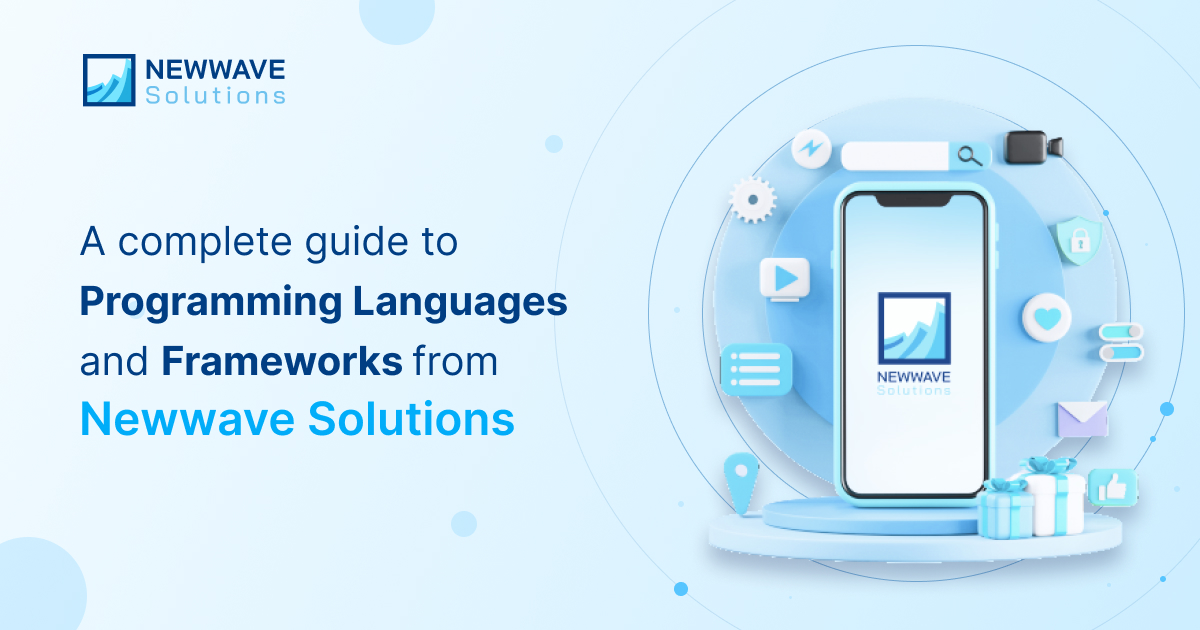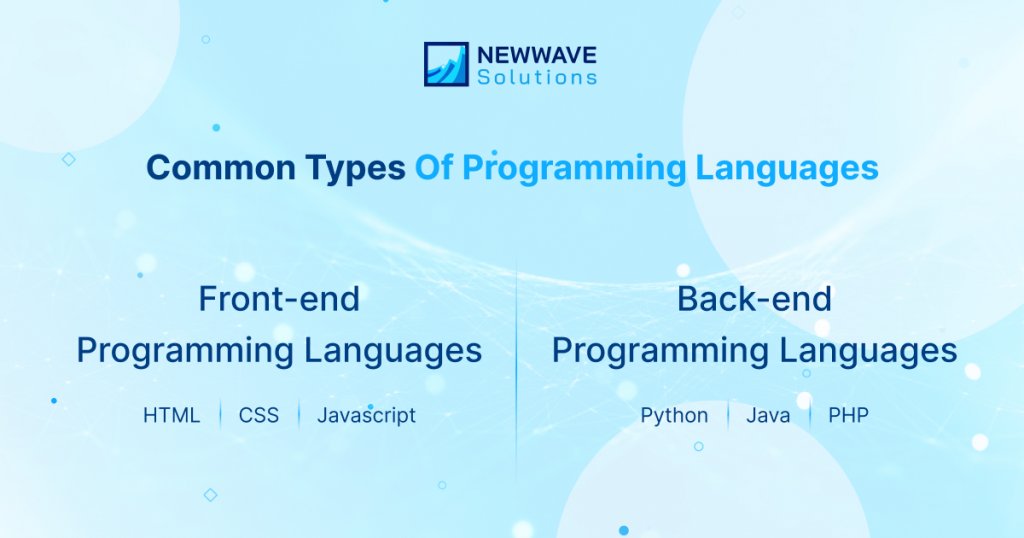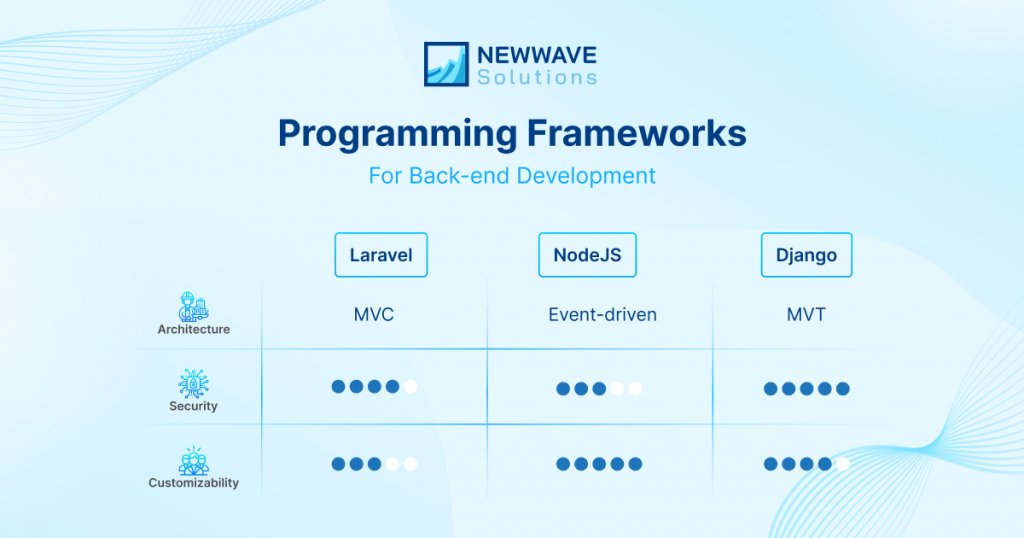

A Complete Guide to Programming Languages and Frameworks from Newwave Solutions

Programming Languages and Frameworks are the foundation of Software Development. There are a lot of options out there, each has its pros and cons, and these are the basics that you must know.
In recent decades, businesses regardless of their sizes invested their resources in technological development to transform a part of their operation. In fact, it’s hard to think of any company being left out of this trend. The demand for digital transformation has empowered the incremental growth of the software development industry, along with the research and development of programming languages and frameworks to support modern software development. It is vital to stay up to date with the latest coding languages and frameworks as using outdated programming languages and frameworks might decrease the competitiveness of your products and services.
On the other hand, applying the latest programming languages and frameworks in software development might bring remarkable benefits, including more reliable and efficient software, increased speed of software deployment, and eliminating bugs and efforts putting on debugs which eventually increase the competitive edge of business.
Although it’s hard to keep updated with the latest version of programming languages and frameworks as it tends to change and improve constantly, still you must not miss out on the basic and the most effective ones. With a solid portfolio and proven expertise in providing software development services, Newwave Solutions would like to share with you the very basic programming languages, and coding frameworks that are relevant today. Let’s dive in.
Table Of Contents
Toggle1. What is software development?
Software development is the process of designing and writing code in programming languages for computer systems, applications, and embedded software. In each type of software, the programming languages and framework vary depending on the nature of the tasks, namely maximizing the system’s efficiency, or performing specific custom tasks. For example, Java, Python, and C++ are the most popular coding languages for developing custom-made apps on macOS or Windows while Java, Python, and C++ are popular choices for writing embedded software code.
2. What are programming languages?
A programming language is a set of rules that converts strings and graphical elements to machine code outputs which are used to implement algorithms in system, software, and applications programming. A programming language often consists of two components – syntax and semantics. Some programming languages, C languages for instance, are defined by specification documents and standards while others have a dominant implementation that is treated as references.
Programming language appears as soon as the creation of computers, through time thousands of them have been developed both in an imperative form (as a sequence of operations to perform), and declarative form (the desired result is specified). According to research results by Statista in 2021, JavaScript, HTML / CSS, Python, C/C++, SQL, and Java are some of the most popular programming languages. You may ask, what are the criteria to rank one programming language over another. In general, an experienced developer could say that the popular programming languages allow user-friendly, flexible and easy-to-read, and streamlined code. In addition to that, it can handle multiple functions while being easy to scale up, secure, and having fewer bugs.
3. Common Types of Programming Languages

It is always useful to understand the programming languages to choose the best-fit solution for your project. Newwave Solutions with proven expertise in software development, have compiled the best programming languages based on different stages of the software development process – back-end development and front-end development. Frontend and Backend are the two most popular used vocabulary in web development. They are very crucial for web development but are rather different from each other. They need to communicate and operate effectively with each other to improve the website’s functionality.
Front-end development concerns user interactions and experience (the ‘client side’ of the application), including style and colors of text, images, graphs and tables, buttons, navigation menu, the structure of websites, and content on browsers. HTML, CSS, and JavaScript are the popular programming languages used for the Front End development of websites, applications, or mobile apps to increase the responsiveness and performance of a system, irrespective of the size of the screen. Meanwhile, back-end development concerns the server-side of the website, applications, and mobile apps which users are not in direct interaction with. The main objectives of back-end development include data management and making sure everything in the background of the system works fine through a set of activities like writing APIs, creating libraries, scientific programming, and working with system components. Although back-end development is invisible to users, the ultimate results are to ensure smooth operation of the system and maximize user experiences.
3.1. Front-end Programming Languages
To develop robust front-end solutions, it’s good to enrich your knowledge of the best front-end programming languages. In this list, we introduce to you our top picks – HTML (HTML5), CSS, and JavaScript.
a. HTML (Hypertext Markup Language):
HTML is the combination of Hypertext – defining the link between system components and Markup language – to define the text documentation within the tag which defines the structure of web pages. HTML5 is the latest version of HTML which is the best choice for building web-fronted apps for mobile devices. With Javascript, HTML5 allows developers to organize intuitive content and optimizes the appearance of the web and apps on any device. The adoption of HTML5 also offers cross-platform support, lightweight files, and easy and clean coding at an affordable price.
b. CSS (Cascading Style Sheets):
CSS is a programming language developed to simplify the process of presenting and styling a web page. In fact, a web tech stack would not be complete without HTML and CSS.
c. JavaScript:
This is an amazing programming language used to increase site interaction, and functionality to running games, complex applications, and web-based software. JavaScript supports object-oriented and functional programming which supports the development and management of web pages and web applications. Yahoo, eBay, Amazon, and Wikipedia are some of the famous brands that use JavaScript to develop their applications on multiple platforms, including Android, iOS, and Windows.
There are many other programming languages that might suit your projects.
3.2. Back-end Programming Languages
Now that we have learned the basics of front-end programming languages, it’s time to put all perspectives together by looking at backend programming languages. Here are our top picks: Python, Java, PHP, and Node.js.
a. Python:
Python is the fastest-growing programming language and one of the most loved languages by developers due to its ease to learn and to code, and integration with other programming languages like C, C++, etc. This universal coding language is used by famous brands like Instagram, Google, Netflix, Quora, Dropbox, Calibre, YouTube, Instagram, Reddit, BitTorrent, OpenStack, Spotify, SurveyMonkey, etc. With Python, developers can handle asynchronous coding, which means alternate processing cycles thanks to the support from the list of programming libraries, both open-source and object-oriented. Due to these advantages, Python has been dominating the market and is being applied in many modern fields, namely artificial intelligence, financial services, and data science.
b. Java:
Java is a cross-platform programming language good for both front-end and back-end development, although it is often used to create all kinds of Android applications being the official programming language of Android. Java is an object-oriented programming language that is highly readable, stable, scalable, and easily manageable, which is great for developing Android apps, server apps, web apps, embedded space, big data technology, scientific apps, websites, and games. Other advantages of Java include not needing a specific hardware infrastructure, being highly secure, and automatic memory management.
c. PHP:
PHP is one of the best object-oriented, server-side coding open-source languages designed specifically for web development. With a huge, active community that uses PHP, there is no wonder 90% of the code of WordPress websites uses this programming language. Besides dynamic websites, PHP also develops Android and iOS apps.
4. What is Software Development Framework?
A framework is a separate block of the software system composed of auxiliary programs, code, libraries, and programming language that can interrelate different components to facilitate the development and integration of various components of a big project. A framework would free developers from the needless coding, and accelerate the progress of coding and developing projects by pre-written codes with a set of standard features, like data storage, security features that can work smoothly on different platforms for the development of websites, web Applications Programming Interface, software, and other resources. Technically, frameworks can be classified into 2 types – Front-end Frameworks and Back-end Frameworks.
4.1. Programming Frameworks for Front-end
If you’re curious what the most popular frameworks in programming for front-end design are, here’s your answer – Note.js, .Net, and Angular.
a. Node.js:
Node.js is an open-source and cross-platform runtime environment for scripting JavaScript code outside a browser. Node.js is used by large companies such as Paypal, Uber, Netflix, Walmart, etc. for building back-end services such as APIs like Web App or Mobile App. Node.js is event-driven, asynchronous, highly scalable, and extremely fast although it is single-threaded. That is the main reason it gains popularity among the large developer community.
b. .NET:
.NET, similar to Node.js, is one of the top programming frameworks that developers prefer to use for front-end development. The advantages of .NET include free of charge, cross-platform, host-agnostic, lightweight, having consistent API common to all .NET implementations, and can build different types of applications. The typical applications of .NET are web, mobile, desktop, games, and IoT.
c. Angular:
Angular is one of the most popular frameworks for front-end development which allows the building of highly scalable, high-performing, and dynamic projects. Angular is designed to simplify the development of user interfaces and overcome the restrictions of other existing technologies which are the main reasons for its increasing popularity.
4.2. Programming Frameworks for Back-end Development.
You are probably wondering which are the best back-end frameworks. Among thousands of programming frameworks available, it is a tough choice to choose. Given the increasing use in recent years, Newwave Solutions suggest you take a closer look at these three-programming languages – Django and Laravel and the run-time environment Node.js. Let’s take a closer look at them.
a. Laravel:
Laravel is a PHP framework that is created by Taylor and Otwell. This free and open-source framework has in-built features such as Authorization & Authentication System and also Easy Integration with Mail System that enables developers to use the pattern of MVC in the development process, so it eliminates the need for writing HTML codes. Laravel has very powerful features that make the development process easy hence reducing the development time. Other advantages of Laravel include an easy content management system, making it easy to build new websites from scratch, easy integration of logic within the website using a blade template engine, and smooth automation of testing work. Although Laravel does not have inbuilt tools and requires third-party integration for custom website development, developers must master PHP before working on Laravel.
b. NodeJS:
NodeJS is neither a framework nor a programming language; however, it embeds all the features above, meaning that no more multi-threading. NodeJS acts as server-side browsing with open-source and eases the development of cross-platform web and applications. The primary reason why developers prefer Node JS is that it works on a single thread which increases the speed and performance of the system. NodeJS is event-based and causes receiving callbacks which enable the server to come back every time it is called and prevents it from being paused or in a sleep state. NodeJS also comes with an excellent package manager, and extensive support in the form of libraries which are best for building APIs and provide quick and easy handling of users’ concurrent requests. It is worth mentioning a drawback of NodeJS is asynchronous programming, that is why not all developers find it easy to understand and it could be difficult to work with.
c. Django:
Django is a Python-based framework that allows developers to use a systematic approach and an easy learning curve for light-weighted, multi-functional systems of web and apps. Django allows seamless collaboration with relational databases, detailed and crisp documentation, and high scalability. Instagram, Mozilla, and Bitbucket are some of the popular brands using Django. Despite various advantages, there are a few drawbacks including it is a single-tiered software application that does not work well with small-scale apps.
In comparison between these three programming languages, Node.js ranks the highest in performance, Django ranks highest in scalability, and Laravel has a set of features that can keep your website one step ahead in the market. In terms of architecture, Django has an MVT architecture, NodeJs is event-driven while Laravel follows an MVC pattern. In terms of security, Django is the best with Laravel coming in second place and NodeJS in third place. NodeJS could have holes and remain unnoticed for a longer period. In terms of customizability, Node.js has the maximum customization options thanks to the support of JavaScript, whereas Django calls for a lot more complexities in customization. Laravel, on the contrary, needs third-party tools to add and personalize the system.

We have taken a look at some of the most popular programming languages and frameworks. Let’s pick the ones that are suitable for your projects, the ones that you should choose and opt for depending on your specific requirements. Remember, each has its pros and cons, one might be better than the other, but the decision has to be made on which one fits your objective the best.
5. Final Thoughts about Top Programming Languages and Frameworks
At this point, you already know the top programming languages and frameworks that would probably gain popularity in 2022. These are the basic knowledge for you to move ahead with your software development project.
If you still hesitate about what tech stack will work best for your solution, Newwave Solutions is always willing to give you a helping hand. With extensive software development expertise for different industries, Newwave Solutions team can guarantee the best relevant tech match for your projects. Contact us for more details!
To Quang Duy is the CEO of Newwave Solutions, a leading Vietnamese software company. He is recognized as a standout technology consultant. Connect with him on LinkedIn and Twitter.
Related News
-

-
 Managing Offshore Teams: Best Practices for SuccessFebruary 5, 2025 View more
Managing Offshore Teams: Best Practices for SuccessFebruary 5, 2025 View more -
 Top 10 Best Offshore Software Development Countries in 2025January 27, 2025 View more
Top 10 Best Offshore Software Development Countries in 2025January 27, 2025 View more












